The artistic expression and cultural legacy that go into Vietnamese handicrafts are priceless. Vietnamese handicrafts, which range from silk and lacquerware to bamboo and rattan works of art, ceramics and pottery, conical hats, and needlework, each one a tale of creativity, tradition, and the deft touch of Vietnamese artists.
Traditional Vietnamese handicrafts are a wonderful representation of the Vietnamese culture and history, which the country is well-known for. The artistry and craftsmanship of Vietnamese craftspeople are on full display in the country's exquisite lacquerware or fragile silk goods. In this blog, we will delve into the rich history of Vietnamese handicrafts, discovering a wide array of techniques that have been preserved over the years.
1. Lacquerware
Lacquerware is one of the country's most recognizable and beautiful traditional Vietnamese handicrafts. The artistic vision and painstaking craftsmanship of Vietnamese artists are on display in their lacquerware, which includes bowls, vases, jewelry boxes, and ornamental objects.
Lacquerware is made by coating wooden surfaces with resin that is produced from the lacquer tree. The lacquer is then painstakingly carved by artisans into beautiful designs, making for long-lasting and visually attractive items.
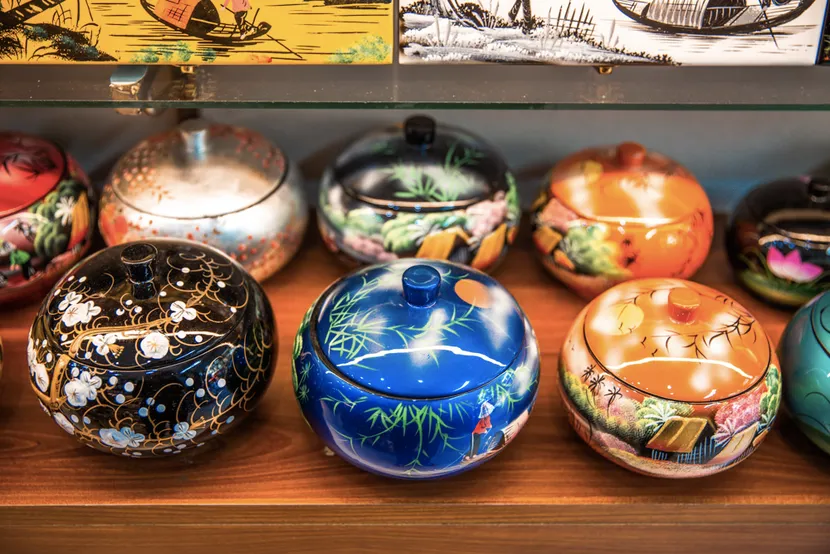
Even while modern mass manufacturing methods exist, the best lacquerware is still handcrafted by artisans in little traditional lacquer villages. These towns have been making lacquerware using methods that have been perfected over many centuries of family tradition.
Because the underlying material (such wood) must be meticulously covered with several thin coats of lacquer, the lacquering process is labor-intensive and time-consuming. It takes days for the lacquer to dry after each coat is applied, and then the artisan must sand it down before adding another layer. The lacquer item is repolished after the necessary layers have been applied. The extraordinary smoothness and sheen of the painstakingly completed item are imparted by the layers of lacquer.

The best lacquer village to visit is Ha Thai. This lacquerware village has a long history of fame as a lacquer artistry center in Thuong Tin Town, Duyen Thai Commune, Hanoi. Once upon a time, this location was responsible for making the exquisite lacquer artwork and goods that the Kings cherished. During the early 17th century, when lacquer art was flourishing, Ha Thai Village came into being. The village was known as "Cu Trang" back then. While it wasn't exactly the birthplace of Vietnamese lacquer traditions, it was well regarded for its abundance of skilled artisans. The "Cu Trang" were selected to deliver goods to the nobility and kings.
Guests are welcome to peruse the many lacquer paintings and goods owned by Ha Thai, which they may also purchase if they so choose. Products come in a variety of sizes and types to cater to the needs of our foreign customers. Photography and art exhibitions would benefit greatly from the village's beautiful, bright, and attention-grabbing wares. From the moment one sets eyes on the flower vase, artwork, bowl, etc., they are captivated by their exquisite appearance.
2. Silk product
Vietnamese people have preserved and continued to use silk throughout the years. In addition to being entirely natural, silk is a luxurious fabric known for its extreme softness, lightweight nature, and long lifespan. To produce silk, mulberry trees must be cultivated to feed silkworms, which in turn produce silk strands.
During the 15th to 18th centuries, during the later Le Dynasty, Vietnamese silk was highly sought after by international merchants. The Thang Long Imperial Citadel, the Pho Hien trading hub in the northern province of Hung Yen, and the Hoi An town in the central province of Quang Nam were popular destinations for these merchants.
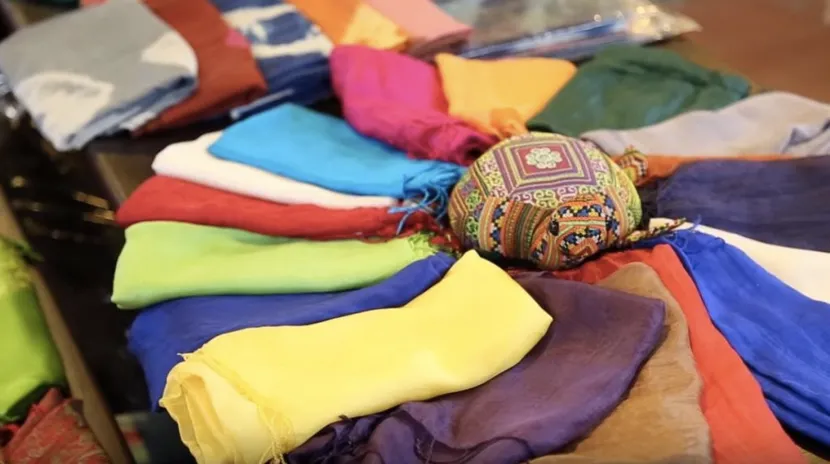
Vietnam is famous for its high-quality silk goods, and the country has a long and storied history of silk production. Vietnamese silkwork is world-renowned for its exquisite beauty and grace, from Hoi An's silk scarves to Hue's embroidered silk paintings. The skilled craftspeople painstakingly construct beautiful garments, accessories, and ornaments by weaving, dying, and embroidery silk threads. Silk from Vietnam is second to none because of its fragility and the painstaking craftsmanship that goes into its production.
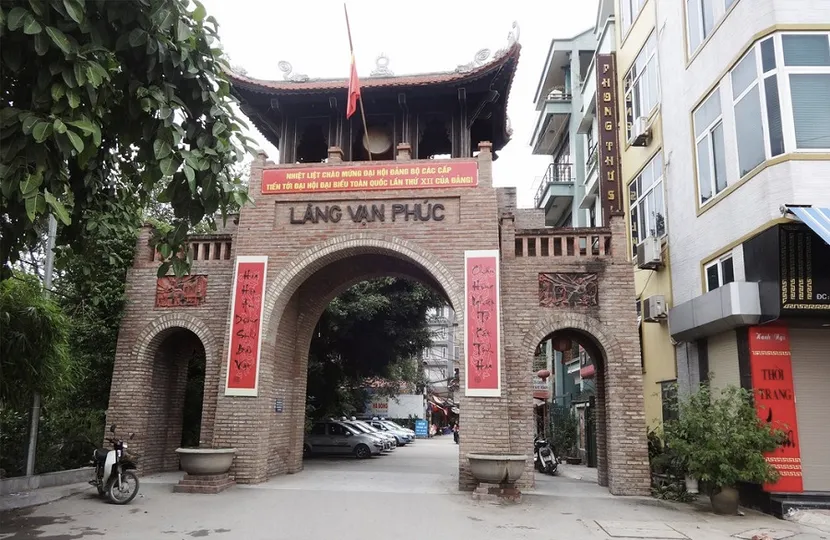
The best silk villages to visit are Van Phuc in Ha Noi City, Nha Xa in Ha Nam province, Co Chat in the outlying district of Thuong Tin in Ha Noi, Bao Loc in Lam Dong, and Tan Chau in An Giang. These are all well-known places for silk weaving. Among them, Van Phuc village is the most well-known when speaking of Vietnamese silk.
More than a millennium has passed since the founding of the Van Phuc silk brand. When the French ruled Indochina, Van Phuc silk was the region's most prized commodity. Most highly prized among Van Phuc artifacts are embroidered silk and 'lua van,' a type of silk fabric woven with delicate patterns in the most refined fashions.
3. Bamboo and Rattan Products
Vietnam is rich in natural materials like bamboo and rattan, which its craftspeople expertly shape into a diverse array of goods. The eco-friendly approach and traditional skill of Vietnamese artists are showcased via a wide range of bamboo and rattan goods, including finely woven baskets, furniture, lampshades, and musical instruments. These products showcase the nation's dedication to eco-friendly procedures while still having their own distinct allure.
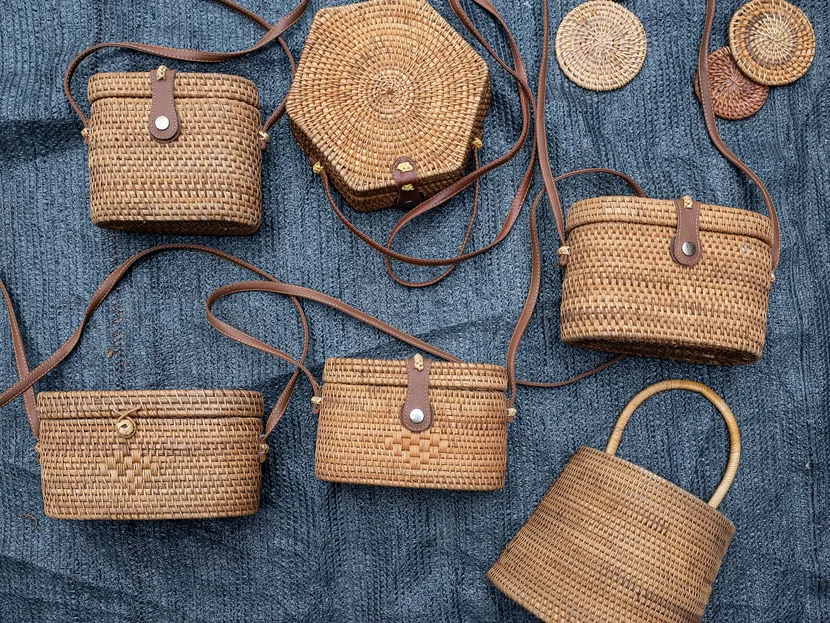
The best bamboo and rattan village to visit is Phu Vinh. Its villagers have been weaving rattan and bamboo baskets for over 400 years, yet no one knows for sure when the first bamboo and rattan goods were created. Once upon a time, in this village known as Phu Hoa Trang, there was a great hill where a flock of white storks lived. The locals made hats out of the delicate stork feathers as a means of monetizing their natural beauty. They started out giving these hats as presents to family and friends, but soon began selling them to the locals. Plates, trays, sieves, baskets, and boxes were among the many domestic items made by the villagers using grasses, bamboo, and rattan threads as an alternative to the more rigid and scarce stork feathers.
Today, variously shaped and decorated bamboo and rattan products have brought fame to the Phu Vinh Village. All sorts of furniture (sofas, shelves, stools, lampshades, picture frames, flower vases, and window blinds), decorations (necklaces, bracelets, and earrings included), and ornamental objects (calligraphy, portraits, and animal sculptures) that demand manual skill are available.
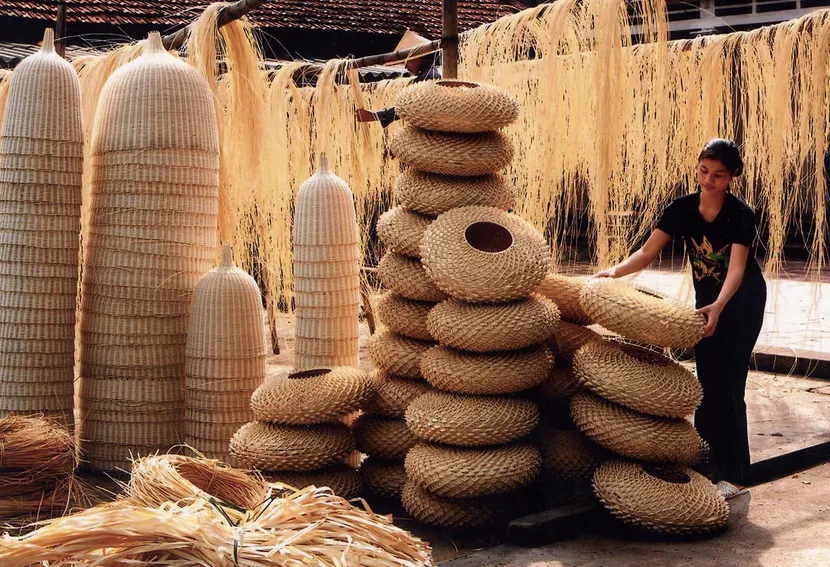
4. Pottery and Ceramics
Vietnam is home to some of the world's most admired ceramics and pottery, which are prized for their artistic value, practicality, and cultural relevance. Ceramics and pottery have been practiced for thousands of years and become the top Vietnam handicraft that we are proud to introduce. Craftspeople use time-honored methods to make beautifully glazed ceramics in unique regional motifs.
The Vietnamese have a long tradition of making pottery. There are hundreds of pottery villages in Vietnam, and some of them are still in operation today, thanks to the country's rich clay soil and the many rivers and streams that run through it.
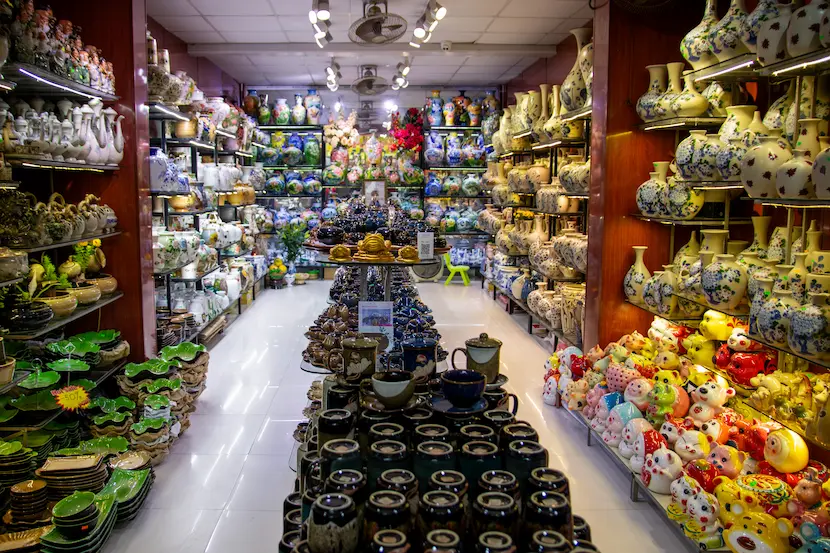
Many historians believe that Bat Trang is Vietnam's oldest pottery village. Bat Trang Ceramic Village Hanoi is said to have emerged even earlier, even though historical sources indicate its establishment in the 14th or 15th century. Today, Bat Trang Pottery Village overlooks the Red River in Hanoi's Gia Lam District. You may easily reach the village by public or private transportation, as it is just 14 kilometers from the heart of the city centre.
The pottery town of Bat Trang produces an abundance of goods, from tableware and ornaments to ritual implements. Two things that set Bat Trang pottery apart from other traditional ceramics villages' goods are the embossed ornamentation and the ivory-white crackle glaze. These features are present in all of their products.
Other pottery villages you can also pay a visit: Kim Lan Village (Hanoi), Tho Ha Village (Bac Giang), Phu Lang (Bac Ninh), Thanh Ha Village (Quang Nam)
5. Conical hat
The famous conical hat, or "Non La" in Vietnamese, is an essential component of Vietnamese handicrafts. Non La is more than a trinket; it's a symbol of Vietnamese heritage.
Not only are these hats a functional headwear item - keeping the sun and rain at bay - but they also hold great symbolic value as a product of the local culture. Careful weaving of the leaves and imaginative structuring of the hat are the hallmarks of Non La's handiwork.
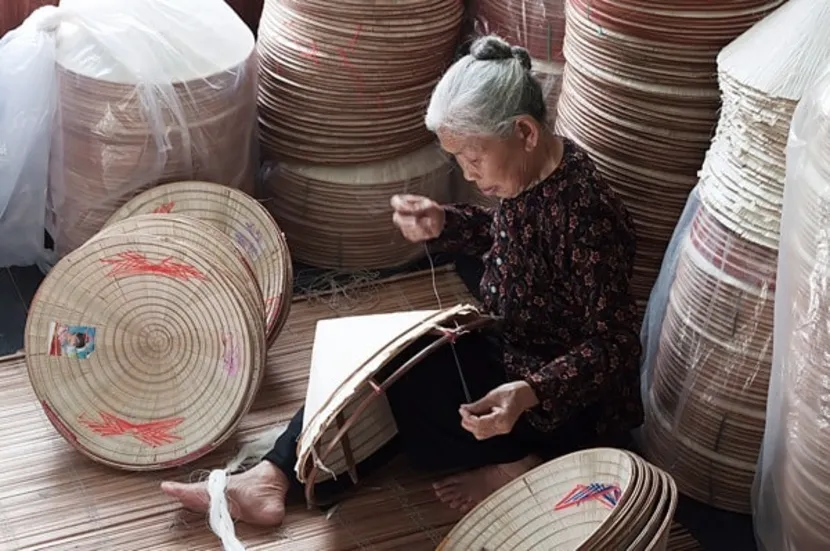
For almost three thousand years, the Vietnamese have been making and wearing conical hats. Conical hats are a common accessory for Vietnamese ladies when they wear traditional costumes, such as the ao dai or ao ba ba.
Although it may not appear complicated, creating a conical hat involves several processes, such as gathering, drying, and ironing material leaves, as well as crafting bamboo frames and weaving. For conical hats, leaves—often those of green palms or coconuts - are the most essential material. The use of pineapple roots as threads - now supplanted by artificial threads - and bamboo for hoops, hems, and frames are two other examples of the materials.
In North Vietnam, the Chuong Village in Thanh Oai district, Hanoi, is the most famous for its glossy, light conical hats. Craftspeople in Chuong village frequently use three layers of verdant palm leaves to strengthen their hats and other headwear.
Thua Thien Hue province is famous for its "poem" conical hats, which are handmade by skilled craftsmen from the Tay Ho Village in the Phu Van region using native "goi" leaves or coconut. Created by sandwiching two sheets of translucent paper with poems and drawings within, a "poem conical hat" consists of two layers of leaves. It is said to be a "poem conical hat" because the poems and pictures will come to life when the hat is held up to the light.
Horse conical hats, or Nón Ngựa, are a distinctive feature of the Phu Gia Village in the Phu Cat district of Binh Dinh province. These hats are usually made of silver or copper and have carvings of various animals, including dragons, unicorns, tortoises, and phoenixes, all of which represent courage, power, and dominance.
6. Embroidery
The exquisite craftsmanship and elaborate patterns of Vietnamese embroidery are world-renowned. Stunning embroidered textile works, from apparel and accessories to wall hangings and home décor, are created by skilled artisans. An aesthetic delight, Vietnamese needlework is known for its vivid colors, precise stitching, and careful attention to detail.
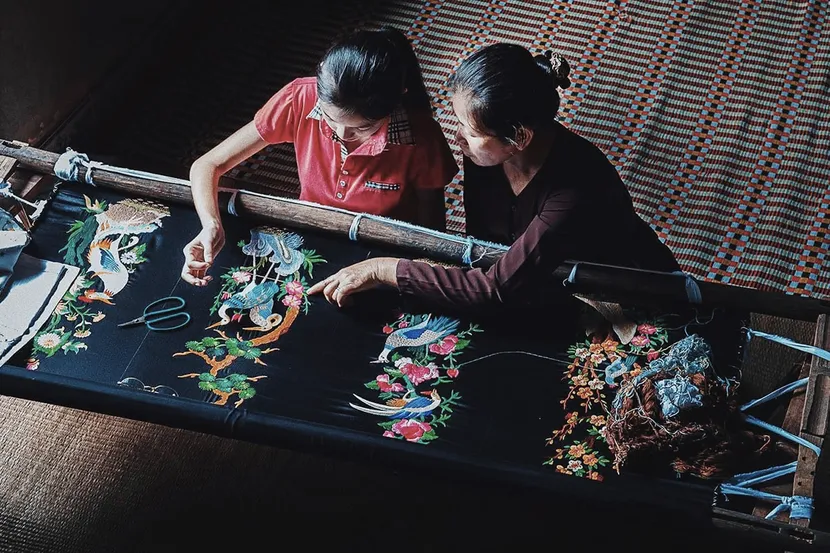
It was in the 17th century that the Vietnamese kings, queens, and other members of the royal family began to wear elaborately embroidered garments made by local talented artisans; this practice continued even after Vietnam's transition to a communist republic.
A physician named Le Cong Hanh, who lived under the Le dynasty, was the first to teach the locals the art of embroidery. On his official mission to a foreign country, he studied embroidery and brought his newfound skill back to the people of Quat Dong. They may have disseminated their needlework techniques across the nation, but the Quat Dong's work is still treasured today.
Two of the most worthy to visit among Vietnam embroidery villages are Quat Dong Village (Hanoi) and Van Lam Village (Ninh Binh). Embroidery in Quat Dong Village and Van Lam Village was originally quite basic. The villagers would embroider distiches or ornamental designs on parasols, altar canopies, and curtains using naturally colored threads, typically yellow, red, mauve, green, and blue. Embroidery was a skill that evolved through time. Later on, embroiderers began to utilize metallic threads and more intricate methods in addition to standard colored threads to produce intricate embroidered designs. The aristocratic class adored the Quat Dong embroidered designs—dragon, phoenix, and butterfly couple—and the peasants who made them were selected to embellish court clothes.
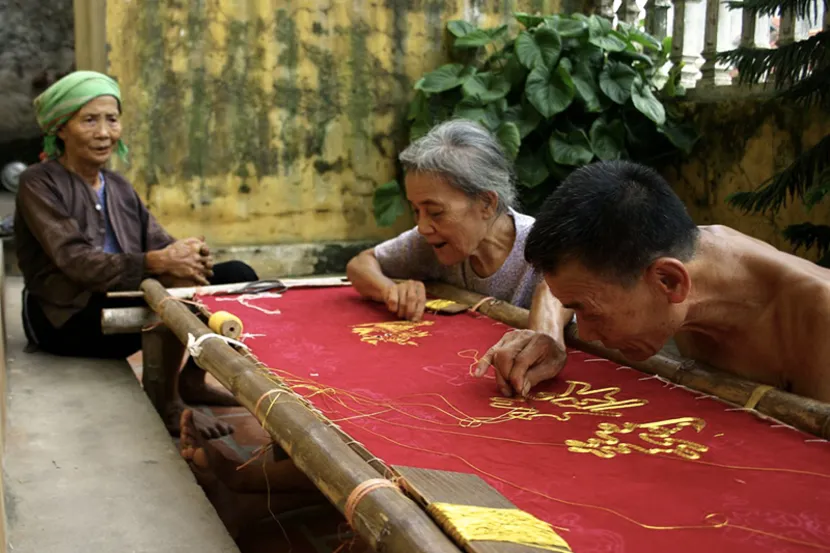
Vietnamese handicrafts provide a window into the country's cultural mosaic, and learning about them helps us appreciate their aesthetic value. Every Vietnamese handcraft is a window into a nation's history and the artistry of its craftspeople. After your Vietnam holiday, you can buy some products for your family, friends, and yourselves as souvenirs. We hope it brings a good memory the next time you see one.
See more:
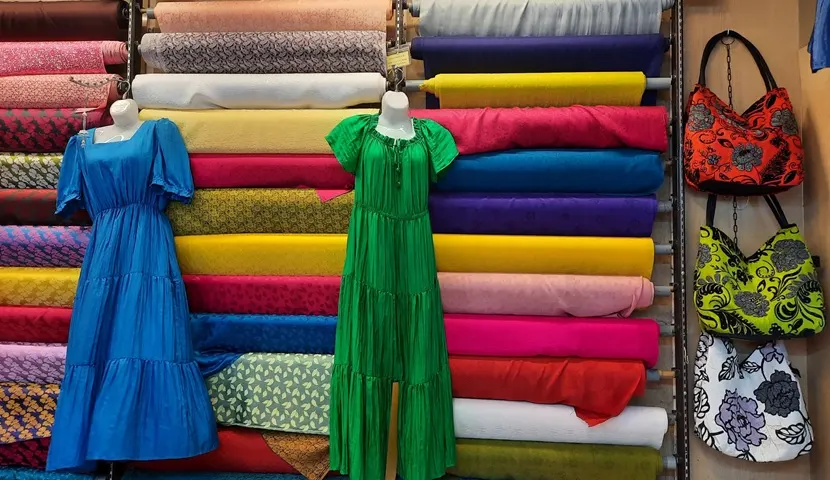







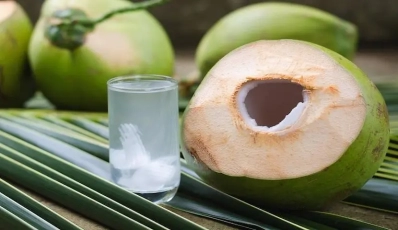




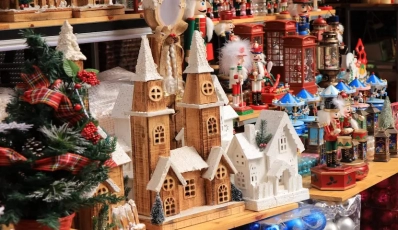







 TRAVELERS' CHOICE 2025
TRAVELERS' CHOICE 2025 



02 Comments
Azerbaijan
Which handicraft makes the best gift for someone who’s never been to Vietnam?
Vietnam
Write Reply